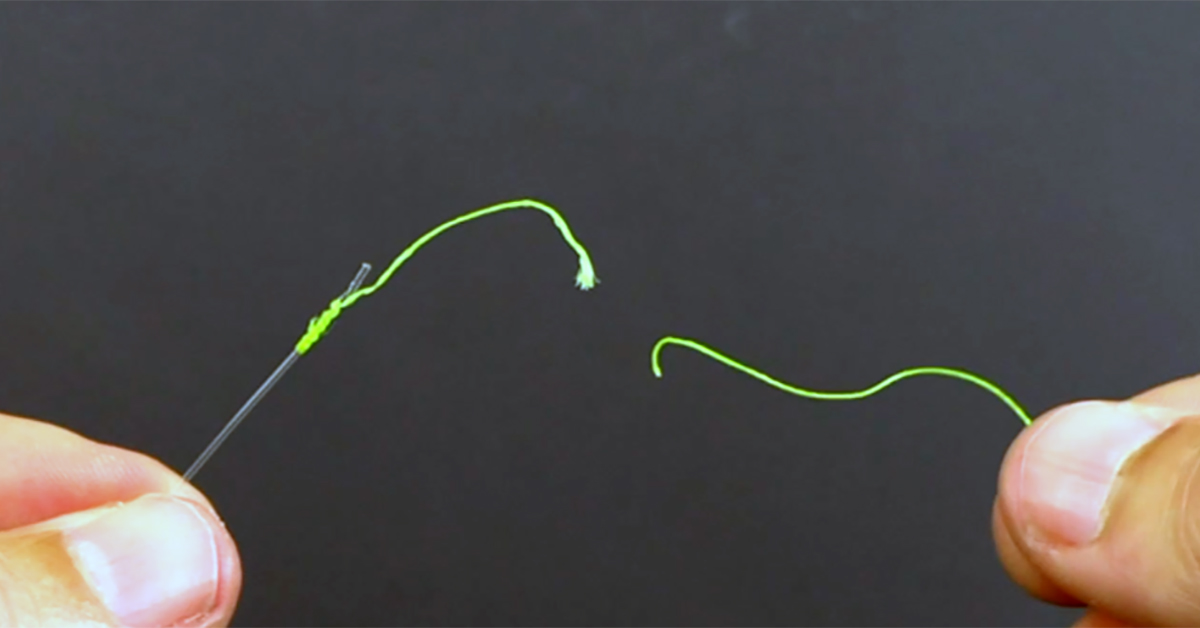Should You Use Saliva When Cinching Down Fishing Knots? [Experiment]
- By: Luke Simonds
- on

Note: This blog post on using saliva to cinch down fishing knots was originally posted on September 11th, 2020, but we wanted to share this important experiment again!! Be sure to scroll down to check out all of the HELPFUL comments below this article!
Should you use saliva when cinching down fishing knots?
Back in the day, it was necessary to use saliva with mono because the surface of the line was rougher and less resistant to abrasion.
But fishing lines today are much higher quality than back then…
So the big question is do you still need to use saliva when cinching down knots or not?
I saw in one study that it actually may do more harm than good, but other experienced fishermen claim that it’s still a necessity.
Since there’s a lot of debate out there, I decided to do a test to find out the truth.
I did three rounds of testing knot strength with saliva, and three rounds of testing knot strength without it.
I did that for monofilament, fluorocarbon, and braided line.
The results were very surprising, and now I know how I’ll be cinching down all of my knots.
Check out the full experiment and the results in the video below.
Should You Use Saliva To Cinch Down Your Knots? [VIDEO]
Not a member? Then click here to join the Insider Club today so you can get access to Smart Fishing Spots, discounts on the tackle in our online shop, and much more.
Are you actually damaging a knot when you use saliva to tie it?
Here are the results of the experiment, measured in the amount of tension required to break the knot:
Fluorocarbon Saliva Test
Fluorocarbon used: 20 lb. Berkley Vanish
Knot used: Non-slip loop knot with two twists
Pre-testing treatment: knots were soaked in water to mimic real-life application.
No Saliva Knot:
- Test #1: 13.05 lbs
- Test #2: 15.66 lbs
- Test #3: 14.80 lbs
- Average: 14.50 lbs
Knot With Saliva:
- Test #1: 15.11 lbs
- Test #2: 13.20 lbs
- Test #3: 11.80 lbs
- Average: 13.37 lbs
Conclusion: The knot without saliva was 8% stronger on average than the knot with saliva.
Monofilament Saliva Test
Monofilament used: 20 lb. Ande Mono
Knot used: Non-slip loop knot with two twists
Pre-testing treatment: knots were soaked in water to mimic real-life application.
No Saliva Knot:
- Test #1: 17.08 lbs
- Test #2: 17.04 lbs
- Test #3: 16.96 lbs
- Average: 17.03 lbs
Knot With Saliva:
- Test #1: 16.48 lbs
- Test #2: 15.97 lbs
- Test #3: 18.45 lbs
- Average: 16.97 lbs
Conclusion: The knots with and without saliva were essentially the same.
Note: notice how much stronger the knots tied with monofilament are than fluorocarbon!
Braided Line Saliva Test
Braided line used: 10 lb. PowerPro
Knot used: Braid uni knot (through the eye twice with 7 turns)
Pre-testing treatment: knots were soaked in water to mimic real-life application.
No Saliva Knot:
- Test #1: 16.67 lbs
- Test #2: 19.29 lbs
- Test #3: 15.54 lbs
- Average: 17.17 lbs
Knot With Saliva:
- Test #1: 21.14 lbs
- Test #2: 16.79 lbs
- Test #3: 19.62 lbs
- Average: 19.81 lbs
Conclusion: The knot with saliva was 12% stronger on average than the knot without saliva.
Experiment Discussion
The surface of the line used to be much rougher, so it was necessary to use saliva to ensure the line didn’t burn on itself as you cinch it down.
However, fishing lines are made so well these days that that no longer happens, so you don’t need saliva.
Not only do you not need it, but it could actually do more harm than good, as shown by the results of the fluorocarbon and monofilament experiments.
Of course, this is a small sample size in just three rounds of testing each, so we can’t say definitely whether one is better than the other, but I believe it’s safe to say that saliva is at least not a necessity like it used to be.
Also, another thing to notice is that the range of results was greater for all of the knots with saliva than those without it.
So yes, it’s possible that saliva could make a knot stronger, but it’s also possible that it could make a knot weaker.
That’s likely because saliva may make the coils in the knot tighten down unevenly, which could decrease the knot strength.
Conclusion

Although it used to be necessary to use saliva when you cinch down a knot, that’s not the case anymore.
In fact, it might even be worse if you use saliva!
I won’t be using saliva with my knots anymore in hopes of getting a more consistent knot and not risking it be much weaker.
What do you think about these results?
Do you wet your knots down before you tighten them?
Let me know down in the comments.
And if you’ve seen the study about whether or not knots should have saliva on them before you tighten them down, please paste a link to it in the comments below!
Finally, if you know someone who always uses saliva on their knots, please TAG or SHARE this with them!
FINDING THE FISH HELP
In order to help make sure that you are targeting the right areas based on the latest feeding trends and upcoming weather forecasts, make sure to use the following 3 resources because they will save you a ton of time.
1. WEEKEND GAME PLANS (UPDATED WEEKLY)
These regional game plans will show you exactly what types of spots to target in under 10 minutes… just click the video to start, and you’ll be informed on what to do on your next trip.
2. SMART FISHING SPOTS PLATFORM (UPDATED EVERY 15 MINUTES)
This exclusive software literally shows you where the most fish are likely to be feeding based on exactly when you’ll be fishing. It factors in the tides, wind, and weather to help you quickly see which areas to target throughout the day.
3. COMMUNITY REPORTS (LIVE FEED)
The Insider Community platform is what you can use to see what is biting near you, and you can get to know other members who fish in your area. Plus, you can use it to keep a log of your catches so you can use past trips to help predict future catches.
Related categories:
STOP WASTING TIME ON THE WATER!
Do what the “SMART ANGLERS” are doing and join the Insider Club.
Here’s what you’ll receive today when you join:
- Weekly fishing reports and TRENDS revealing exactly where you should fish every trip
- Weekly “spot dissection” videos that walk you through all the best spots in your area
- Exclusive fishing tips from the PROS you can’t find anywhere else
- Everything you need to start catching fish more consistently (regardless if you fish out of a boat, kayak, or land).



 Weekend Game Plan Lessons
Weekend Game Plan Lessons






Interesting results. I learned fishing fly-fishing on rivers and I was told the reason to use spit was to keep the line from curling around where the knot was tightened. Maybe that was an old wives tale or maybe it had to do with the small tippets we use there. BTW I love your job.
Given how smooth the surface of the lines made now (vs. years ago), I don’t believe that saliva is needed for even the super thin lines.
Thanks Luke. Very interesting and as always, thanks for giving us the real scoop. Looks like someone could write a novel on this with all the variables.
Really good info.
Those were very surprising results, I have always used saliva on my knots so I never would have even thought it could be worse then good.
Thanks for running tests like these, they can be eye opening!
thanks
I like tests, numbers, results, explanations! This is why we join!
I notice the break point for every knot is well under the line strength. A table of values for average break point of all your favorite knots tied on all the most popular inshore line weights would be an invaluable table of knowledge. It would also show what size line we SHOULD be using. Another test could show break points pulling on the reel drag.
I have lost so many fish due to knots coming undone, I apply a very small amount of super glue gel to all my hook knots if tied off the water. Works for me.
Which knot or knots are you talking about?
Great video. Really informative. I believe the importance in order is: line, rod then reel. The knot makes all the difference in the setup. Ive always used the more affordable rod and reels in my budget. Just recently I landed a 38″ black drum using a Zebco 404 prespooled with 10# mono to a 30# mono leader. Me and that big ugly danced on the bank for about 20 minutes. I used a simple uniknot but looped the mainline thru the swivel twice, wetted the line and cinched tight.
As always ,good post.Thanks
Great information!
As always Great information Luke